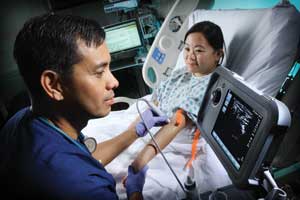Ultrasound-guided Technology Eases IV Insertion
by Jennifer Walker
![]() Suburban Hospital nursing staff face a persistent challenge: Many of their older patients have small veins, making it difficult to insert an IV on the first stick.
Suburban Hospital nursing staff face a persistent challenge: Many of their older patients have small veins, making it difficult to insert an IV on the first stick.
“It creates trauma in the patient, emotionally and physically,” says critical care resource nurse Zandro Tejada, BSN, RN, MPH, ATCN, CCRN. After several unsuccessful attempts, patients also may need a central line, which carries an increased risk of infection. How can nurses ensure they get the IV right the first time? The answer may lie in new ultrasound-guided technology.

“The very good thing about this [technology] is that we know where to stick the patient,” says Tejada, who has performed five ultrasound-guided IV insertions on patients with extremely hard-to-see veins. “We know the location and we just do it once and we get it.”
In a 2011 study by the Emergency Nurses Association of America, patients who had once endured an average of 6.4 sticks to insert an IV needed only an average of 1.3 attempts when staff used an ultrasound machine. Nurses used the technology with a 97 percent success rate.
Suburban’s nurses “have been amazed that they can see veins they normally can’t see,” says Barbara Jacobs, MSN, RN-BC, CCRN, CENP, the hospital’s Chief Nursing Officer.
Here’s how it works: Nurses place probes on patients’ arms, then look on a laptop-sized screen to clearly see veins that would be nearly invisible on the skin, leaving little room for error when they insert IVs. The ultrasound screens also help nurses discern veins from arteries, which will pulsate on the monitor, reducing the chances that patients will bleed internally from a rare accidental artery stick and contract hematoma, Tejada adds.
Supported by a grant from PNC Charitable Trust, Suburban resource and emergency room nurses and technicians learned how to use the technology in a half-day training led by physicians from George Washington University. Using the technology works to benefit patients in two ways, says Jacobs: “to decrease the discomfort of repeated IV sticks for our patients and to decrease the number of central lines [our patients need].”